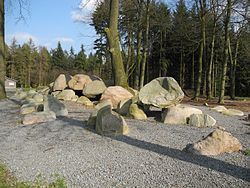Giersfeld
| Giersfeld | ||
|---|---|---|
|
Megalithic plant Grumfeld West near Ankum |
||
|
|
||
| Coordinates | 52 ° 29 '12.5 " N , 7 ° 52' 46.1" E | |
| place | Ankum , Lower Saxony , Germany | |
| Emergence | 3500 to 2800 BC Chr. | |
The stone grave field Giersfeld is located in Westerholte near Ankum in the district of Osnabrück in Lower Saxony and is part of the street of megalithic culture .
A circular hiking trail that explains the prehistory, called the Giersfeld Stone Grave Trail, has been leading to prehistoric monuments since 1975, which can only be found in a few places in this density in northern Germany . The approximately 3.5 kilometer long stone grave path encloses 500 hectares and is signposted from a parking lot at Artland Golf Club. The facilities of the stone burial ground bear the numbers 9a to 9i of the street of the megalithic culture .
The stone grave route is named after six megalithic structures on the circular route. Destructions of the last centuries have occurred between 3500 and 2800 BC. Some of the monuments that were created in BC and whose builders were the carriers of the funnel beaker culture (TBK) are heavily burdened, but still look impressive , for example, the Grumfeld West stone grave , the Rickelmann 2 stone grave and the stone box on Giersberg. Grumfeld West is one of the “ magical places ” in the city and in the district of Osnabrück, which are marked by a white three-sided pyramid .
Burial mound
At the end of the Neolithic Age , a new burial custom emerged. The dead were buried in or under round mounds of earth, three of which are on the hiking trail. The barrows are sometimes in the immediate vicinity of the megalithic complexes. For almost 3000 years, from the late Stone Age (from 2800 BC) through the Bronze and Iron Ages to around the birth of Christ, burial mounds were built in the north. Formally, they only differ in terms of their dimensions. However, excavations have shown that there are different burial customs behind this, depending on the age and possibly also the region. There are burials:
- at the level of the original earth's surface
- in tree coffins
- in stone boxes
- in pits under and in the hill
- in wooden fixtures in the hill
- in burial mounds with keyhole trenches
In the Bronze Age, urns appear after the beginning of cremation , which in western Lower Saxony are seldom and associated with modest grave goods.
Stone box
The Bronze Age stone box on Giersberg is located southeast of Westerholte and has no Sprockhoff number. as it was only discovered a few years ago and restored with intermediate masonry. The box, which is exactly rectangular, is sunk into a hill and has three bearing stones on the long sides and one end stone on one side and three on the other. Since the bearing stones are about one meter high megalithic blocks and not slabs, it can be assumed that the box is relatively old. The stone box discovered in a mound of earth looks like the scaled-down version of a large stone grave whose cap stones are missing. During the reconstruction of the tomb, the pavement-like hill surface was also restored from rubble.
See also
literature
- Anette Bußmann : Stone Age witnesses. Travel to the prehistory of northwest Germany. Isensee, Oldenburg 2009, ISBN 978-3-89995-619-1 , pp. 46-48.
- Mamoun Fansa : large stone graves between Weser and Ems. Isensee, Oldenburg 1992, ISBN 3-89442-118-5 , pp. 86-87.
- Ernst Andreas Friedrich : The megalithic graves on the Giersfeld. In: Ernst Andreas Friedrich: If stones could talk. From the history of Lower Saxony. Volume 1. Landbuch-Verlag, Hanover 1989, ISBN 3-7842-0397-3 , pp. 33-35.
- Ernst Sprockhoff : Atlas of the megalithic tombs of Germany. Part 3: Lower Saxony - Westphalia. Edited from the estate by Gerhard Körner. Rudolf Habelt, Bonn 1975, ISBN 3-7749-1326-9 , pp. 115-118.
- Friedrich-Wilhelm Wulf , Wolfgang Schlüter (archaeologist) : Archaeological monuments in the independent city and in the district of Osnabrück (= material booklets on the prehistory and early history of Lower Saxony. Series B: Inventories. 2). Hahn, Hannover 2000, ISBN 3-7752-5661-X .
Web links
Individual evidence
- ↑ Archaeological Working Group for the City and District of Osnabrück e. V .: Discover magical places and experience the landscape. Tour 6








